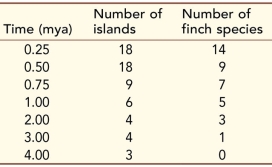The different finch species in the phylogeny shown in the 22.8 of the textbook have all evolved on islands of the Galápagos archipelago within the past 3 million years.Molecular clock analysis (see Chapter 23) has been used to determine the dates of the various speciation events in the phylogeny.Geological techniques for dating rock samples (see Chapter 24) have been used to determine the ages of the various Galápagos islands.The table shows the number of species of Darwin's finches and the number of islands that have existed in the archipelago at several times during the past 4 million years.  Plot the number of species of Darwin's finches and the number of islands in the Galápagos archipelago (dependent variables) against time (independent variable).
Plot the number of species of Darwin's finches and the number of islands in the Galápagos archipelago (dependent variables) against time (independent variable).
Are the data consistent with the hypothesis that isolation of populations on newly formed islands is related to speciation in this group of birds? Why or why not?
Definitions:
Male Infant
A young human male child, typically in the age range from birth to one year.
Female Infant
A young female child, typically considered to be under one year of age.
Aphagia
Failure to eat; may be due to an unwillingness to eat or to motor difficulties, especially with swallowing.
Lateral Hypothalamus
A region of the brain involved in regulating hunger and thirst.
Q25: Consider a hypothetical enzyme-coding gene and sequences
Q34: Which scenario is least likely to lead
Q52: Two groups of turtles diverged from one
Q131: The proliferation of a large number of
Q142: Refer to the table. <img src="https://d2lvgg3v3hfg70.cloudfront.net/TB5650/.jpg" alt="Refer
Q151: Which statement is true?<br>A) Radioisotope dating of
Q162: Why can lateral gene transfer be advantageous
Q183: Consider five species of toads (A-E).Species A
Q192: Which of the following is a major
Q238: The most likely reason that crickets (Laupala)